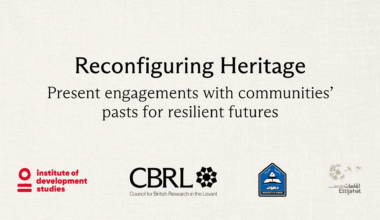CBRL Amman successfully concluded its Hands-on Training on Heritage Documentation, funded by the Commonwealth Heritage Forum (CHF). This initiative introduced traditional tools and skills necessary for documenting and preserving post-1750 Jordanian architectural heritage to 20 new graduate architects from Jordan, Palestine and Syria, as well as representatives from various municipalities across Jordan.
Over two weeks, participants explored heritage documentation and preservation, blending theoretical insights with practical fieldwork across Jordan through site study tours and on-site technical training at heritage sites and settings in Amman, Jerash, As-Salt, and Madaba. The training programme was delivered by professionals from leading organizations, such as the Jordan Engineers Association Heritage Committee, the Jordan Museum, Greater Amman Municipality, ICOMOS-Jordan, Yarmouk University, German Jordan University, the Hashemite University, IMKAN Construction and various individual experts.
Figure 1: HE Eng. Ihab Amarin, the Director of the Jordan Museum during his session on Understanding the Architectural and Urban Heritage.
The training focused on the importance of documentation as the first crucial step in protecting heritage. It covered international and local heritage protection frameworks, the history of documentation, assessment of conditions and threats, manual tools for recording heritage, urban heritage mapping, and the socio-economic values of Jordan’s architectural history.
Participants visited diverse heritage sites such as Dar al Saraya in Madaba and the Roman East Baths in Jerash. Heritage walks in Amman and As-Salt allowed participants to engage with the cultural essence of these cities, mapping heritage elements at the urban level, exploring traditional architectural details, and gaining hands-on experience with construction techniques.
Figure 2: The trainees during the Heritage Walk in As-Salt, with the trainer, Eng Sana Taani.
Figure 3: At a local souvenir shop in Jabal al Weibdeh before the heritage walk with Mukhtar al Weibdeh, Eng. Omar al Faouri.
The trainers equipped participants with essential skills, marking the beginning of a journey. CBRL will stay in touch with participants as they submit their final reports, ensuring that the knowledge acquired during the program is shared and applied in their academic or practical work. A workshop on research funding resources is scheduled next year to assist participants in exploring funding opportunities for heritage-related research and projects.
Figure 4: During practical training in Dar al Saraya in Madaba with the trainer, Eng. Safaa Joude
CBRL plans to build upon this programme in the future, incorporating training on digital documentation techniques and continuing to partner with local and international institutions. The project has not only supported participants to build on their skills but has also facilitated a network, career opportunities, and capacity building in heritage preservation.
The CBRL Amman team extends their gratitude to the dedicated trainers, passionate participants, and the Commonwealth Heritage Forum (CHF) for their support in making this project a success.
Figure 5: A group photo of the training participants with Prof. Naif Haddad, the Dean of Queen Rania Faculty of Archaeology and Tourism, Dr Carol Palmer, former Director of CBRL, Dr Jane Humphris, CBRL Director, and the CBRL Amman team on the last day of the training.














